The base is the most important element of any structure: from a light garden arbor to a capital high-rise country mansion. This is the beginning of the building and its foundation in the literal sense. The strength, durability and safety of the building operation depend on how correctly selected, designed and made the foundation. The question of what type of foundation to choose arises at the planning stage of construction. The optimal solution in many cases will be the decision to build a columnar foundation with your own hands: a step-by-step instruction on how to perform work can give a complete picture of the principles of its design and the intricacies of the construction process.
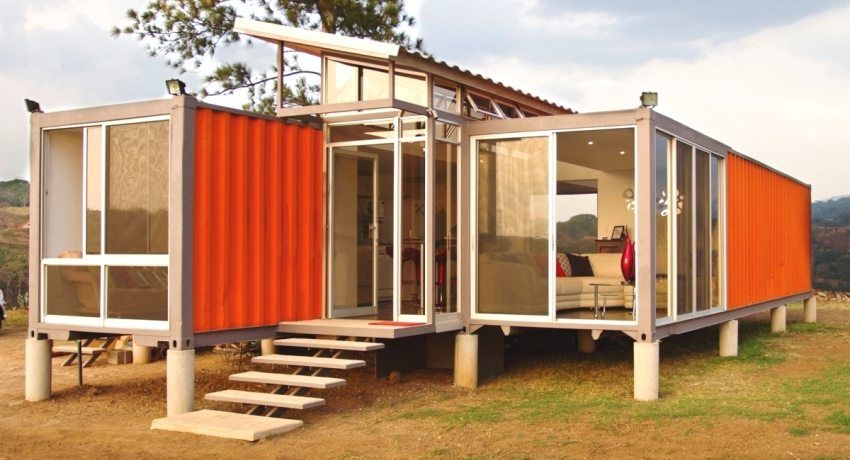
Advantages and disadvantages of a pillar foundation
Designed independently and equipped with their own hands, columnar foundations for frame houses and buildings without basements that do not exert strong pressure on the ground are simple to perform and relatively cheap.
Helpful advice! Pillar foundation – the optimal solution for lightweight buildings, the volume weight of which does not exceed 1000 kg / m3 (frame houses, bathhouses, hozblok, garden houses, terraces, sheds, garages, summer kitchens, gazebos, etc.).
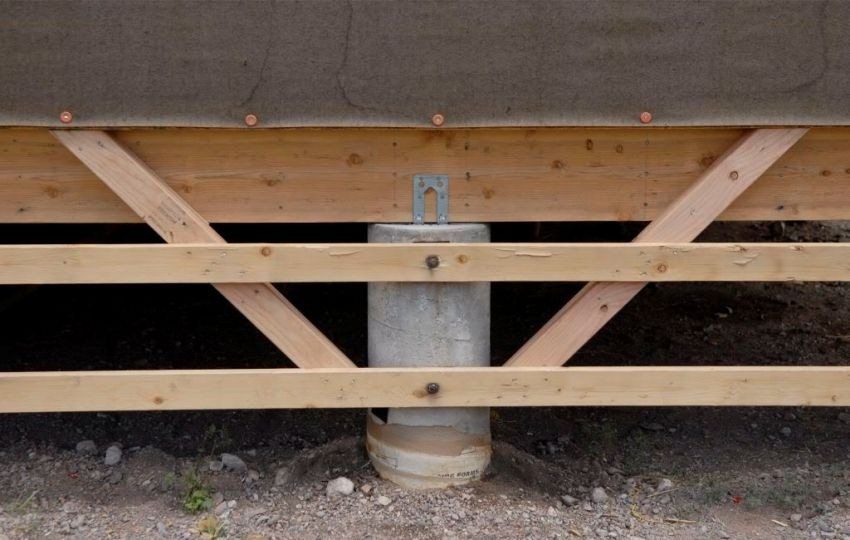
According to reviews, the support-column foundations have a rather impressive list of advantages:
- Can be designed, calculated and built independently, without the involvement of special equipment and specialists.
- Can be arranged on virtually any soil (excluding those where heaving processes are possible or there are highly located groundwater).
- They can be located in areas with noticeable differences in height (and even on the slopes of hills).
- Do not require preparatory work on the alignment of the landscape.
- Can be erected in the shortest possible time (the maximum time for the construction of a columnar foundation from scratch is 2 weeks).
- Do not need complex and expensive waterproofing.
- The strength and durability of the structure (erected with careful observance of the technology of work column foundation can serve more than half a century).
- Relative low total cost.
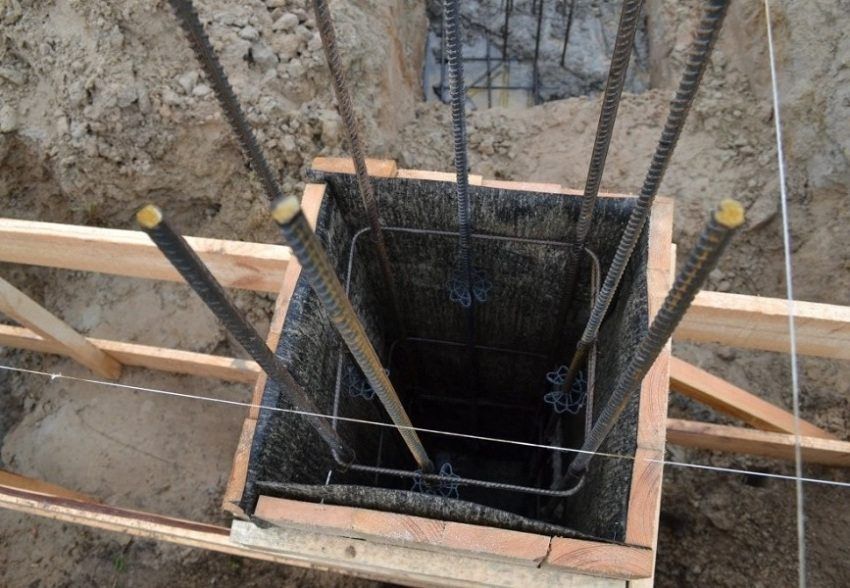
At the same time, there are only two drawbacks to the column foundations:
- Not designed for heavy brick buildings and multi-story buildings.
- The creation of basements is excluded.
Before proceeding with the detailed design and calculation of the column foundation, you should decide on which site, what type and on what technology the building will be erected on it. These factors determine the choice of material for the columnar foundations of the basement and the depth of their foundation.
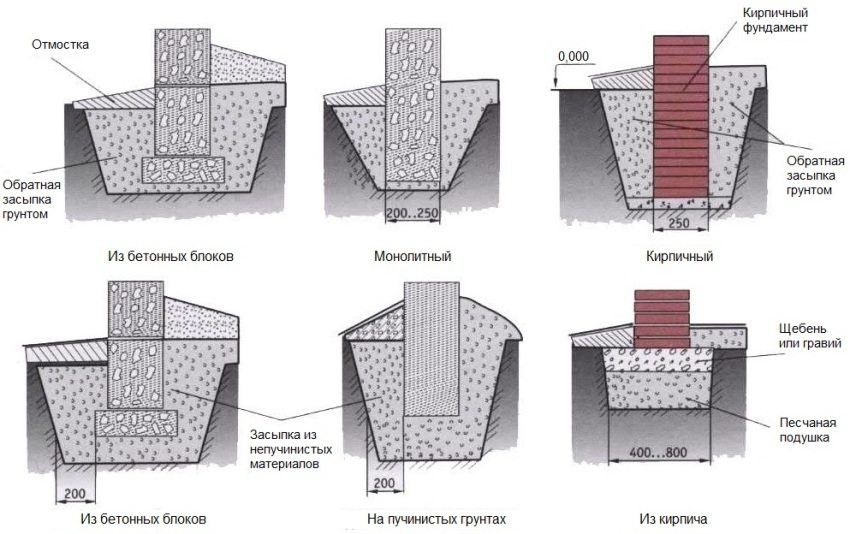
The following materials can be used for foundations:
- reinforced concrete;
- butobeton;
- blocks;
- brick;
- a natural stone;
- tree;
- pipes: asbestos or plastic.

The depth of the column foundation is determined by its design, the technological parameters of the structure and the geological characteristics of the soil in the building spot.
Helpful advice! On sandy soil, in which groundwater is at a level below 1 meter, a columnar foundation with a slab structure can withstand a brick cottage.
The depth of the columnar bases are divided into three main types:
- Recessed – with a depth of laying below the mark of soil freezing.
- Shallow-depth – with a depth of 40–70 cm from the ground level.
- Non-buried – located on the surface of the earth in the complete absence of the underground part. At the same time, in places where the posts are installed, a fertile layer is removed from the soil and non-metallic material is added.
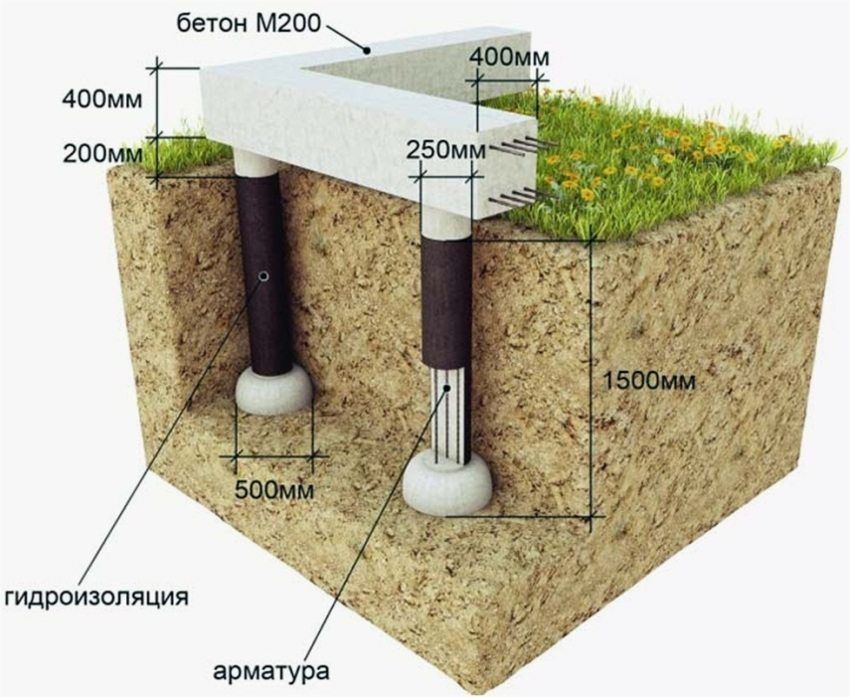
For the construction of a columnar base with your own hands, step-by-step instructions are needed as the most detailed and visual guide.
In general, the support-column foundation construction is a system of supports of the smallest possible cross-section located at the load concentration points: in the corners of the building, at the intersection of the walls, under the supporting beams, piers, under the furnace. To determine the number of free-standing columns, the distance between them is assumed to be 1.5–2.5 m. In order to connect the foundation pillars into a single structure, a grillage is made between them.
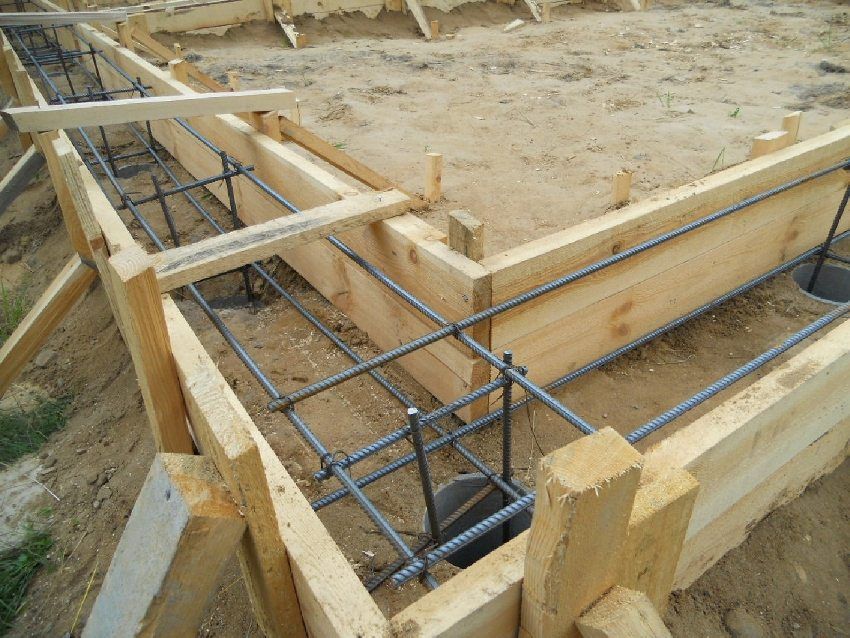
The height of the pillars above the zero mark is individual and depends on the design features of the grillage.
The construction of the column foundation begins with the calculation. Most likely, for independent calculations you will need a program like “Foundation” or some other that can be found on the Internet and is free to download. To work with such programs you will need the following parameters:
- The depth of the basement and its reinforcement.
- Location of the future structure.

The technology of building a foundation with column supports also requires additional data:
- Approximate weight of the building, including the weight of its intended interior and furnishings.
- The total weight of the foundation itself.
- Seasonal load (wind and snow cover).
- Variety of soil and its properties.
- The level of soil freezing and the average temperature in the winter season.
- The level of groundwater occurrence, taking into account its seasonal fluctuations.
As a result of the calculations, the following values will be obtained, which are necessary for the construction of the column foundation:
- The minimum number of pillars.
- The cross-sectional area of the pillars and their dimensions.
- The size of the bearing capacity of the pillars.

The columnar non-submerged foundation on the supports, located with a step of 1.5-2.5 m, is used quite often. Such foundations can be erected on unflattering and weakly crushing soils, while the building (wooden or panel house, bath, hob, extension or summer kitchen) has a small area and, accordingly, a small weight. Moreover, if the construction is carried out on rocky, coarse-grained or not prone to movement of the soil, this type of foundation can also be arranged under a log or timber house that is large enough in size. It is also possible to build a foundation on non-buried supports provided that the influence of heaving forces on the structure is reduced. For this, the soil under the supports is replaced with a sand pad.

As a material for the pillars, it is possible to use concrete, butobeton, sand concrete or concrete blocks for the foundation, the sizes and prices of which are very diverse. However, most often they take foundation blocks with dimensions of 20x20x40. The price of such a foundation, as well as the number of blocks required for its construction, can be calculated independently or with the help of a “foundation” online calculator. You can also make a column foundation of bricks with your own hands, but it should be noted that the use of silicate or ceramic bricks with low frost resistance is unacceptable.
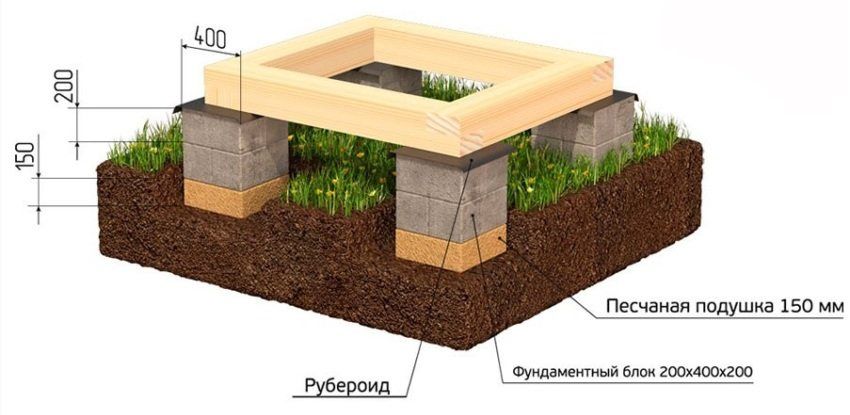
Work on the construction of a non-buried column base from prefabricated blocks can be divided into several main stages:
- The layout of the future construction site, cleaning the soil, the device drainage layer and waterproofing works.
- Determination of the location of the supports for the foundation (concrete blocks 20x20x40). It is better to buy all the materials in advance.
- Preparation of places for support. The device is a sand pillow under each support.
- Installation of supports, each of which consists of at least 4 blocks for the foundation 200x200x400. The price of the entire foundation with the knowledge of this condition is considered very easy. The pillars (according to the instructions and photos) of the column foundation from blocks 20x20x40 are laid out in two rows with their hands in staggered order. For the joints, thick undiluted cement mortar is used, the open part of the blocks should be finished with plaster.
- Obligatory waterproofing of foundation supports at the junction with the house with bitumen mastic, roofing felt, tar or glass insulation.
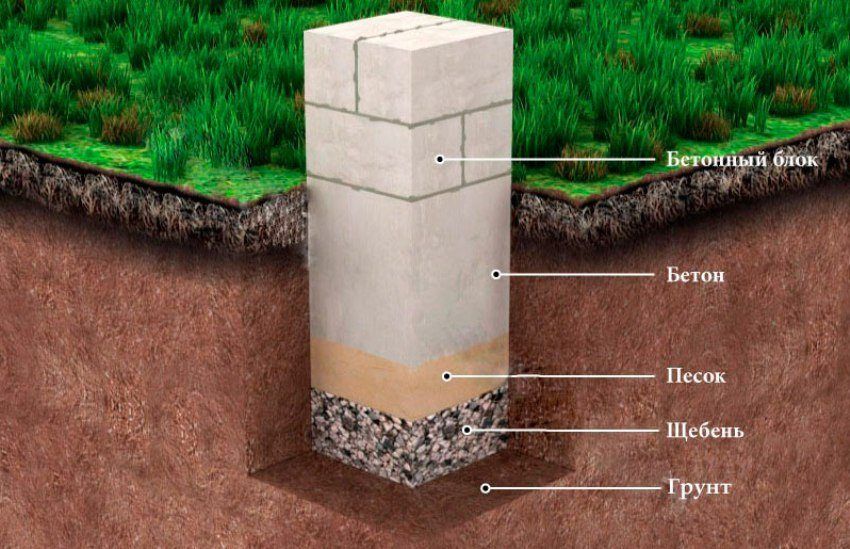
Helpful advice! Sometimes (for example, in the case of the installation of a columnar foundation for a bath) the supports can also be wooden – from butt parts of oak or pine with a diameter of 20-30 cm, impregnated with tar or used oils. To increase the stability of the support, it is immersed in a 10–15-centimeter layer of concrete solution, poured into a hole that was previously opened.
When making a foundation with your own hands from 20x20x40 blocks, video clips and step-by-step instructions will help you understand the technology of work, understand the process and more accurately estimate financial costs.
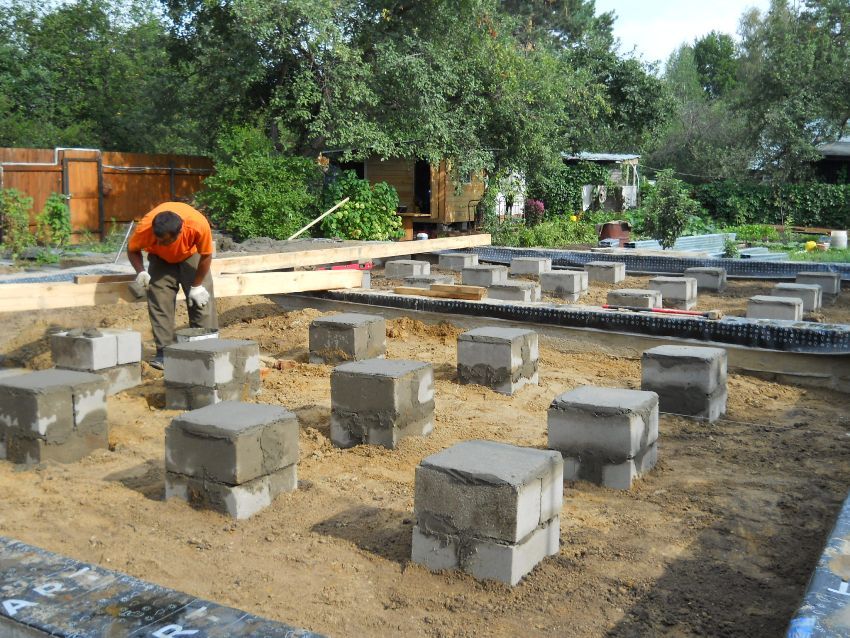
The shallow foundation is one of the most popular varieties of the column foundation. The means and efforts that its device requires are minimal, and the range of use for frame-type buildings is very wide.
As a basis for a frame house or light bath, they often make a columnar foundation using pipes as a formwork for a concrete mix. Since the reinforced concrete pillar will take over the entire load, the material of the pipes is of no particular importance: both plastic and asbestos pipes, usually used for sewage networks, will be suitable.
Calculating the cost of most types of columnar foundation can be done independently using special online calculators or programs. Many of them are fairly easy on the Internet, free and have an intuitive interface.

